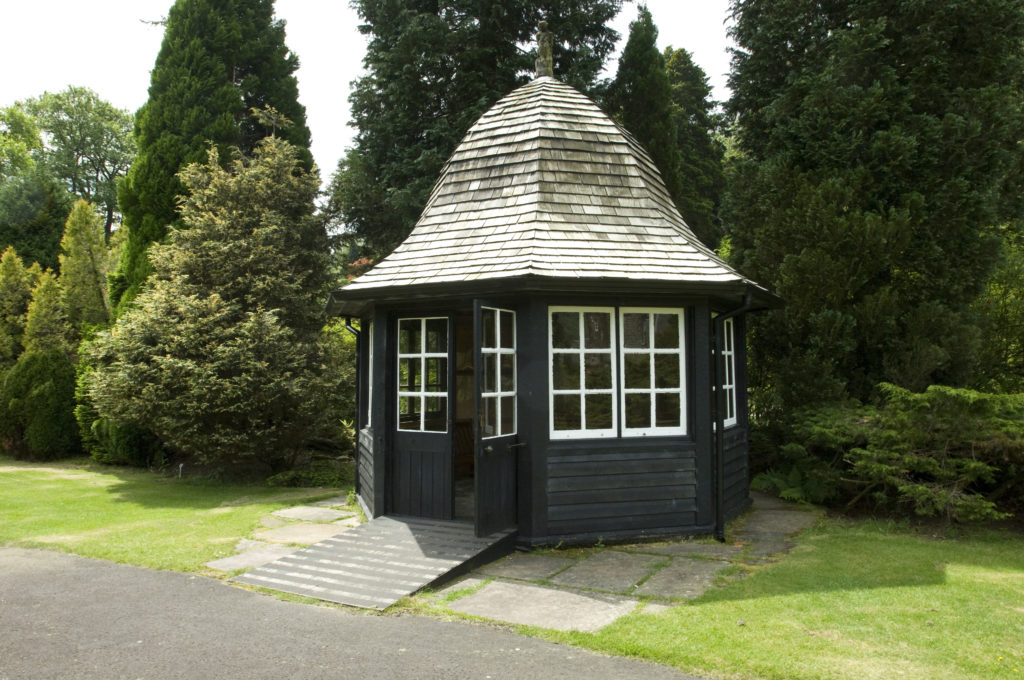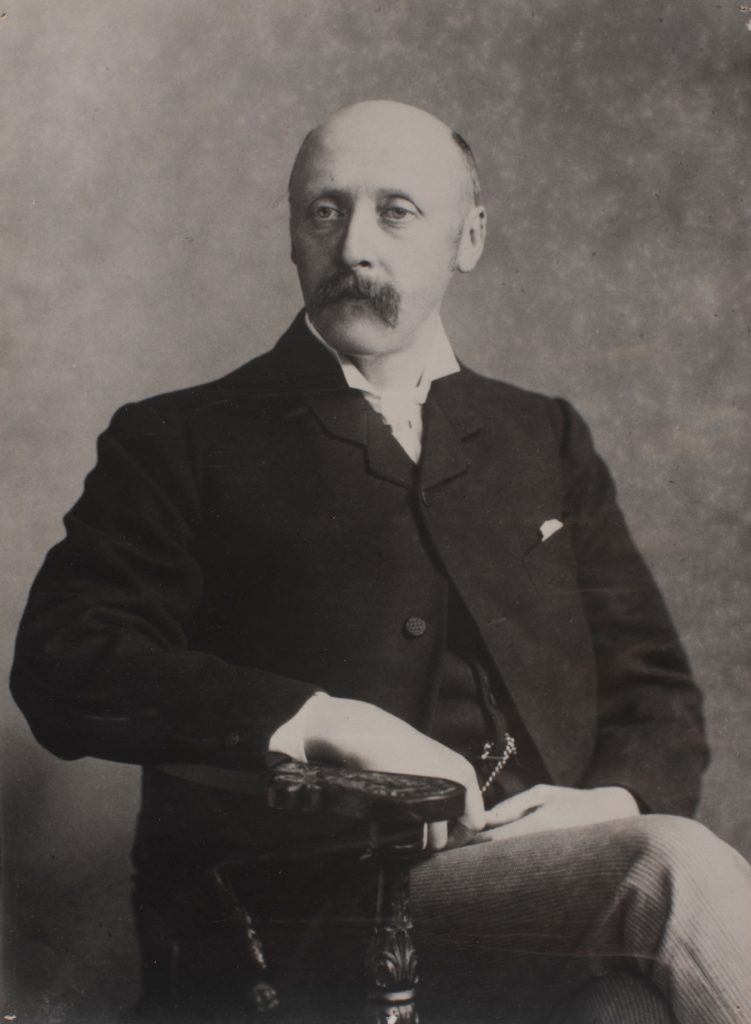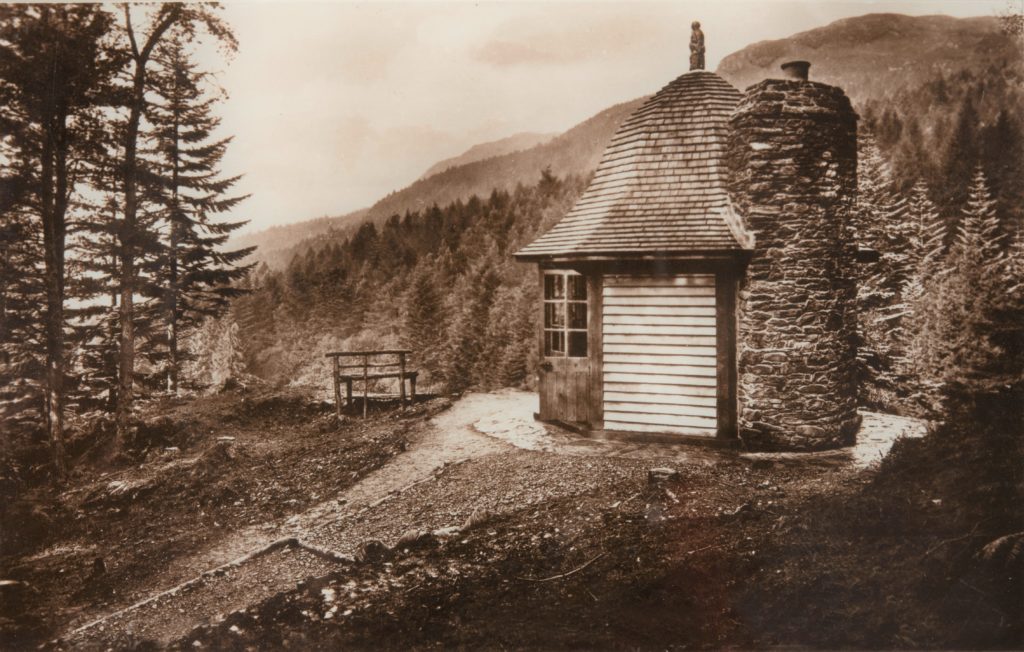
Puck’s Hut, the small octagonal building in the Walled Garden at Benmore will be familiar to visitors, but probably few realise that, if buildings spoke, this modest structure would tell how the garden became an integral part of the Royal Botanic Garden Edinburgh. Inside, an inscription carved in stone provides a starting point to the story.
THIS HUT AND GLEN ARE DEDICATED
BY HIS FRIENDS TO THE MEMORY OF
SIR ISAAC BAYLEY BALFOUR
IN FULFILMENT OF A PLAN HE CHERISHED
What was the “plan he cherished” and why was a “glen” mentioned and not the Walled Garden?
Sir Isaac Bayley Balfour was one of the towering figures in the history of the RBGE. Regius Keeper from 1888 to 1922 he served through the Great War, working with skeleton staff and enduring personal tragedy, while ensuring that the RBGE would re-emerge as one of the great botanical gardens in the world. He was knighted for his research into the moss genus Sphagnum which would save the lives of many wounded soldiers and was a prime mover in the re-forestation of Scotland. His was a prescient voice: that trees purified the air by the process of carbon assimilation, reduced extremes of temperature, and controlled the flow of water from the soil.

During the latter part of his period as Regius Keeper new plants were flooding into the country, notably from the expeditions of George Forrest. Concerned that Edinburgh might not provide suitable growing conditions Bayley Balfour started to look for a site where the new introductions would thrive. Using his connections, he obtained agreement from the recently formed Forestry Commission for the allocation of ground at Glenbranter, 12 miles north of Dunoon. Bayley Balfour had hoped to step down immediately after the end of hostilities but delayed until achieving his cherished plan, retiring in 1922 and dying only a few months later.
As the first Rhododendrons were arriving moves were afoot to create a memorial to Bayley Balfour, a rest house for visitors to Glenbranter. A small committee was established, comprising Sir John Stirling Maxwell, professor W Wright Smith (Bayley Balfour’s successor), FRS Balfour (who later donated Dawyck to the RBGE) and John Sutherland as secretary. A public appeal was launched but, when donations were starting to come in, there was a change in direction: Harry George Younger, of the brewing dynasty, gifted the Benmore estate to the nation, to establish a school of forestry, a national arboretum and botanical garden. The site of the proposed memorial rest house was moved to Benmore, not to the Walled Garden, but to a dramatic ravine, half a mile from the entrance to the garden. This fern draped gorge was named Puck’s Glen by the Scottish artist William (Crimea) Simpson who, in Victorian times, had imagined it as a home for sprites and fairies.
The architect chosen to design Puck’s Hut was Sir Robert Lorimer, Scotland’s pre-eminent architect. Well known for his arts and craft inspired country houses and the Scottish National War Memorial, Lorimer also had an abiding interest in the use of local materials and, in particular, wood. He had recently designed a barn-like ‘village hall’ as a display for the Royal Scottish Arboricultural Society at the 1924 British Empire Exhibition, to showcase the range and quality of Scottish grown timber. Puck’s Hut allowed Lorimer to develop this theme, using local timber sourced from the Benmore estate, prefabricated in the contactor’s workshop in Edinburgh for ease of transport to the somewhat inaccessible site.

The opening of Puck’s Hut in 1928 coincided with growth of the outdoor movement and the recreational use of the countryside, as a consequence of the Great Depression, high unemployment, and the urge to escape the cities. In 1936 Puck’s Glen was included in the Argyll National Forest Park, the forerunner of the Loch Lomond and Trossachs National Park. Walkers could climb up to Puck’s Hut on its platform above the glen, and brew up on its open fireplace, the wood smoke from the stone chimney drifting through the trees. By the 1960s the world had changed and a decision was taken to re-locate Puck’s Hut in the Walled Garden at Benmore, without its chimney but with the memorial plaque still in place.
Archived documents help unravel the mystery of Puck’s Hut to reveal not only its history, but also to show how this modest building is a part of a much wider story about the beginning of the botanical garden at Benmore and its relevance today, following in the great tradition of Sir Isaac Bayley Balfour.
The book by David Gray (Senior Horticulturist at Benmore) has been sponsored by the Younger (Benmore)Trust, continuing the work it began in 1928 to support the development and appreciation of Benmore Botanic Garden.
“Cherished Plan: The Story of Puck’s Hut at Benmore” is available from https://rbgeshop.org/products/cherished-plan-the-story-of-pucks-hut-at-benmore
